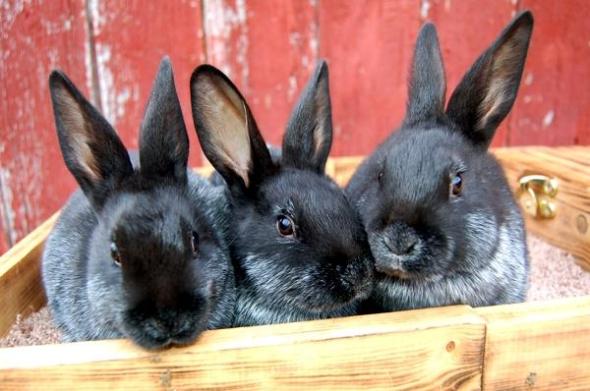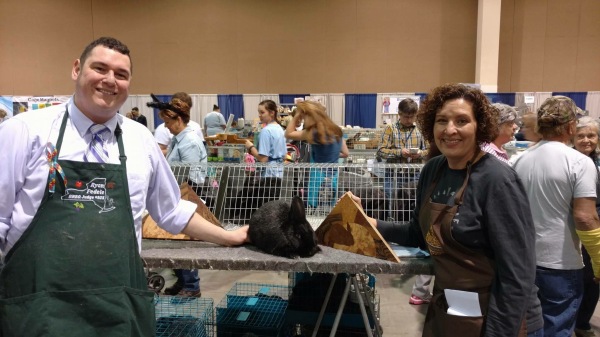
Also known as the French Silver, the Champagne d’Argent is one of the oldest known breeds of rabbit in the world. Originating in the Champagne province of France more than 400 years ago, he was prized for both his meat and for his beautiful silvery coat. Born pure black, Champagne d’Argents begin to develop their beautiful silvery ticking at about 3 weeks of age and will continue to change until they mature at about 6 months of age. At this time, they will be a striking silvery-gray throughout, with black shadowing along the ears, tail, face and legs.
The French Silver’s History
Rabbits have been domesticated for hundreds of years, but the selective breeding of rabbits began in Europe during the Middle Ages. Much as they enjoyed selectively breeding their prized hounds, the art of rabbit breeding quickly caught on and, as early as the 1500’s, various breeds of rabbit and different color varieties were already being cataloged and traced. The Champagne d’Argent would be one of the first and would quickly gain popularity throughout his native France and the rest of Europe.
Champagne d’Argents can be found in the United States, though it may take a bit of searching. While strikingly beautiful, they are a commercial breed and are often overshadowed by larger and more compact breeds, like the Californian or New Zealand White. Equally troublesome is that, while their pelt is beautiful, it is often passed over in favor of more versatile white-furred rabbits. This makes the Champagne d’Argent less desirable to some. Still, fanciers of the breed stand behind the Champagne d’Argent, as well as the more popular variety, known as the Creme d’Argent or Orange Silver. Gradually, the breed has been gaining more and more popularity throughout the United States and Canada.
The Champagne d’Argent’s Appearance
So what does a Champagne d’Argent look like? Well, that can be a very good question, depending on when you take a look at him! Believe it or not, the Champagne d’Argent is much like a Lipizzan horse, in that he’s born pure black and slowly silvers out as he matures. By 2-3 months, they can appear almost downright comical with their mixture of black baby fuzz and silver adult coat. Some even sport Lone Ranger-like masks and unique swirling patterns – you can never be bored, raising Champagne d’Argent bunnies!
Champagne and Creme d’Argents were both bred for meat, as well as their beautiful pelts and, because of this, they were expected to bulk up and mature quickly. By the time an Argent is 3 months of age, he should weigh at least 4.5 pounds. As a mature adult, the Champagne usually weighs an average of about 8 pounds. While they still produce a good amount of meat, it’s obvious why they are usually passed over for the 9-11 pound rabbits that are commonly bred for commercial use.
Champagnes As Pets
Champagne d’Argents are known for their docile temperament, as well as their striking color. Due to their size, however, they are not a very common household pet bunny. Additionally, the fact that this is still a relatively uncommon breed often makes them a little harder to come by, as well as often making them a little more pricey to purchase. Advocates of the breed, however, are quick to say that they are worth every penny, between their beautiful “old silver” coloration and sweet temperaments. If you’re looking for a unique bunny, you just may find a Champagne d’Argent to be what you want.
So how do you find a reputable Champagne d’Argent breeder? I highly recommend going through the American Rabbit Breeder’s Association, local Champagne d’Argent Breed Clubs, or even your local Cooperative Extension office for more information. Another good way to choose a bunny is to attend a local rabbit show in your area – not only is it a good way to spend the day, but it also gives you the opportunity to watch different rabbits being judged, hear the judge discuss the good qualities of the breed, and grants you a perfect opportunity to speak to a wide variety of different breeders. Beware, though – those bunnies are so adorable, it’s hard not to come home with a whole car full!
Sources:
A.R.B.A. (American Rabbit Breeder’s Association) Standard of Perfection
http://www.arba.net/ – ARBA’s website
http://voices.yahoo.com/rabbit-breed-profiles-champagne-dargent-5943988.html











